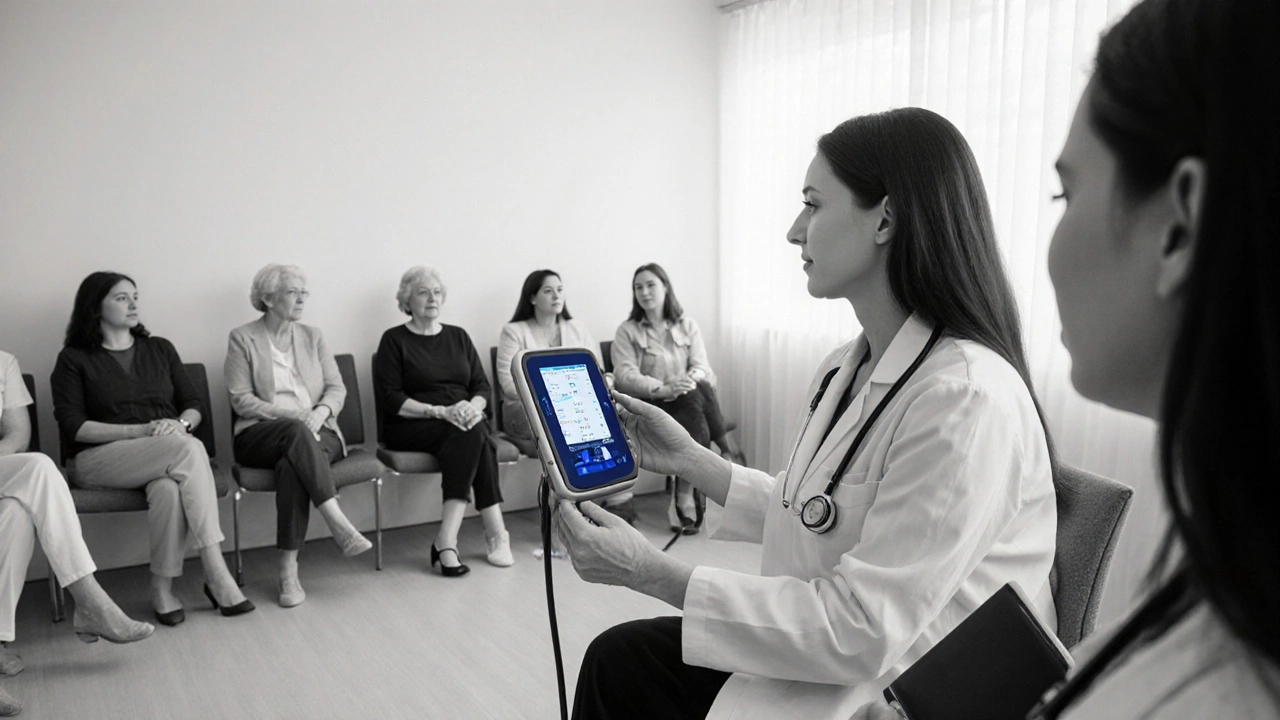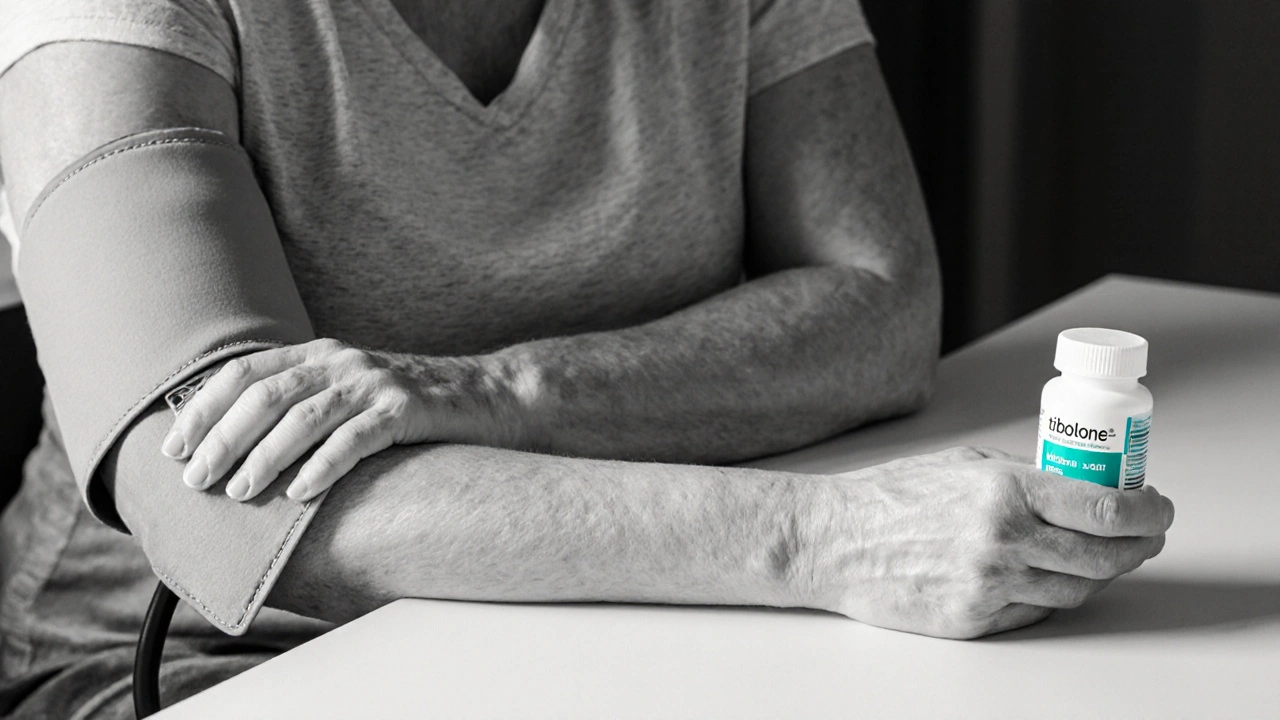Tibolone Blood Pressure Risk Calculator
Blood Pressure Input
Enter your current blood pressure readings
Your Risk Assessment
Based on clinical studies and FDA guidelines
Feeling a sudden rise in blood pressure after starting a new menopause pill? You’re not alone. Many women wonder whether tibolone blood pressure interactions could jeopardize their heart health. This guide cuts through the medical jargon, explains what tibolone does, how it may affect your numbers, and what you can do to stay safe.
What is Tibolone?
Tibolone is a synthetic steroid that mimics the actions of estrogen, progesterone, and testosterone in the body. It’s marketed primarily for post‑menopausal women to relieve hot flashes, improve bone density, and boost sexual desire. Unlike traditional hormone replacement therapy (HRT), tibolone’s metabolites bind to different hormone receptors, offering a “balanced” profile that many clinicians find appealing. The drug is taken orally, usually 2.5mg daily, and has been available in Europe and parts of Asia for over two decades.
How Blood Pressure Works
Blood pressure is the force exerted by circulating blood on the walls of arteries. It’s expressed as systolic over diastolic (e.g., 120/80mmHg). Systolic pressure reflects the heart’s contraction, while diastolic pressure measures the resting phase. Persistent elevations-known as hypertension-strain the heart, kidneys, and brain, increasing the risk of stroke and heart attack. Lifestyle, genetics, and hormonal fluctuations all play a role in shaping a person’s blood pressure profile.
Does Tibolone Influence Blood Pressure?
The short answer: the evidence is mixed, but most large studies show little to no dramatic impact on average blood pressure. However, individual responses can vary, especially in women with pre‑existing hypertension or cardiovascular disease.
Key clinical trials provide a clearer picture:
- The LIFT trial (Long‑term Intervention on Fractures with Tibolone) followed 4,500 post‑menopausal women for five years. Researchers reported a mean systolic change of +1.2mmHg in the tibolone group versus +0.8mmHg in placebo-a difference that didn’t reach statistical significance.
- A 2022 meta‑analysis of 12 randomized controlled trials (RCTs) involving 6,700 women found a pooled systolic increase of 0.9mmHg and diastolic increase of 0.5mmHg-both within the margin of measurement error.
- Conversely, a subgroup analysis of women with baseline hypertension (SBP>140mmHg) showed a modest but consistent rise of 2-3mmHg in systolic pressure when on tibolone.
In practice, these numbers mean tibolone isn’t a major driver of high blood pressure for most users, but caution is warranted for those already on the edge.

Comparison of Blood‑Pressure Outcomes in Tibolone Studies
| Study | Population | Duration | Systolic Δ (mmHg) | Diastolic Δ (mmHg) |
|---|---|---|---|---|
| LIFT (2011) | Post‑menopausal, avg. age 62 | 5years | +1.2 (tibolone) vs+0.8 (placebo) | +0.7 vs+0.4 |
| Meta‑analysis (2022) | 6,700 women, mixed risk | 1-3years | +0.9 (overall) | +0.5 (overall) |
| Hypertension Sub‑group (2020) | Women with SBP>140mmHg | 2years | +2.4 | +1.1 |
Who Is at Higher Risk?
Even if the average effect is small, certain groups should keep a closer eye on their readings:
- Hypertension patients-especially those with uncontrolled SBP>160mmHg.
- Women with a history of cardiovascular disease, such as prior heart attack or stroke.
- Individuals taking other medications that raise blood pressure, like non‑steroidal anti‑inflammatory drugs (NSAIDs) or certain antidepressants.
- Smokers, heavy alcohol consumers, or those with high body‑mass index (BMI>30kg/m²).
These risk factors amplify the modest pressure shifts tibolone may cause, making regular monitoring essential.
Monitoring and Managing Blood Pressure on Tibolone
Guidelines from the Endocrine Society and the FDA suggest a systematic approach:
- Obtain a baseline blood‑pressure reading before starting tibolone.
- Re‑check after 4-6 weeks of therapy.
- If systolic rises by ≥5mmHg or diastolic by ≥3mmHg, discuss dose adjustment or alternative therapy with your clinician.
- For patients with pre‑existing hypertension, schedule monthly checks for the first three months.
- Document any symptoms (headaches, dizziness) that could signal pressure spikes.
When a rise is detected, the first step is usually lifestyle modification-more on that below-before adding antihypertensive drugs such as ACE inhibitors or calcium‑channel blockers.

Practical Tips for Staying Within a Healthy Range
Here are concrete steps you can take while on tibolone to keep blood pressure in check:
- Salt smarter: Aim for under 1,500mg of sodium daily. Replace processed foods with fresh fruits, vegetables, and legumes.
- Move daily: Even a brisk 30‑minute walk can lower systolic pressure by 4-5mmHg over weeks.
- Watch caffeine: Limit coffee/energy drinks to two servings a day, as excess caffeine can cause temporary spikes.
- Stay hydrated: Dehydration can raise blood pressure; drink 1.5-2L of water daily.
- Weight management: Losing 5% of body weight can reduce SBP by 5mmHg.
- Stress reduction: Practices like mindfulness, yoga, or deep‑breathing have shown modest blood‑pressure benefits.
- Medication review: Inform your doctor about over‑the‑counter meds (e.g., NSAIDs) that might counteract tibolone’s neutral effect.
Remember, tibolone isn’t a magic bullet. Its primary goal is to alleviate menopausal symptoms, so pairing it with heart‑healthy habits maximizes overall well‑being.
When to Consider an Alternative
If after three months you still see a steady rise in blood pressure despite lifestyle tweaks, discuss switching to another form of HRT. Options include:
- Low‑dose estradiol combined with a progestogen.
- Transdermal estrogen patches, which have a lower impact on clotting factors.
- Non‑hormonal options like duloxetine for hot flashes.
Each alternative carries its own risk‑benefit profile, so a shared decision‑making conversation with your clinician is key.
Frequently Asked Questions
Can tibolone cause dangerous spikes in blood pressure?
In most women, tibolone leads to only a minimal rise-typically under 2mmHg. Dangerous spikes are rare and usually occur in those who already have uncontrolled hypertension or are taking other pressor drugs.
How often should I check my blood pressure while on tibolone?
Get a baseline before starting, then re‑measure at 4-6 weeks. If you have pre‑existing hypertension, weekly checks for the first month and monthly thereafter are recommended.
Does the dose of tibolone matter for blood pressure?
Standard doses (2.5mg daily) are the most studied. Higher doses have been linked to slightly larger blood‑pressure shifts, so clinicians rarely prescribe above the approved amount.
Should I stop tibolone if my blood pressure rises?
Not immediately. First, assess lifestyle factors and ensure accurate measurement. If the rise persists (>5mmHg) despite interventions, discuss dosage reduction or switching therapies with your doctor.
Is tibolone safe for women with a history of stroke?
Women with prior stroke or transient ischemic attack are generally advised against tibolone because of its estrogenic activity, which can modestly increase clotting risk. Alternative non‑estrogenic treatments are preferred.

Comments (11)
Michael Barrett
October 16, 2025 AT 14:25
When you read the tibolone overview, you might think the numbers are merely statistical footnotes.
In fact, each datum represents a cascade of physiological interactions that can be parsed with almost philosophical rigor.
Consider the LIFT trial: a modest systolic rise of +1.2 mmHg, yet the confidence interval flirts with zero, which begs the question-does a decimal matter in the grand tapestry of cardiovascular risk?
Moreover, the meta‑analysis aggregates twelve RCTs, yielding a pooled increase of 0.9/0.5 mmHg; such precision is impressive, but also illustrates the law of large numbers smoothing out individual outliers.
If you examine the hypertension subgroup, the rise jumps to +2.4/ +1.1 mmHg, a figure that, while still modest, may sit atop a precarious plateau for patients already teetering on the brink of hypertension.
Thus, the data do not scream a crisis; they whisper a caution, especially for those with baseline SBP>140 mmHg.
Physiologically, tibolone’s estrogenic metabolites influence vascular tone via nitric oxide pathways, while its progestogenic aspects modulate renin‑angiotensin activity-mechanisms that can both dilate and constrict vessels depending on the individual's receptor milieu.
One could argue that the net effect is a near‑zero balance for the average woman, but that argument collapses under the weight of heterogeneity.
Lifestyle variables-salt intake, exercise, stress-intersect with hormone therapy, creating a multidimensional risk surface that no single trial can fully map.
Hence, clinicians advise baseline BP measurement, a 4‑6‑week follow‑up, and a threshold of ≥5 mmHg systolic or ≥3 mmHg diastolic rise before contemplating dose adjustment.
From a practical standpoint, incorporating a sodium‑restricted diet, regular aerobic activity, and weight management can offset the modest pressure shifts attributed to tibolone.
If you neglect these adjuncts, the drug’s neutral profile may tilt toward a modest hypertensive effect, especially in the presence of NSAIDs or certain antidepressants.
Conversely, embracing the recommended lifestyle tweaks often yields a 4‑5 mmHg reduction, effectively neutralizing the drug‑related increase.
In sum, tibolone is not a silent assassin of blood pressure; it is a modest participant in a larger orchestra of cardiovascular determinants.
Therefore, the prudent patient monitors, the vigilant clinician interprets trends, and together they ensure that the therapeutic benefits outweigh the minuscule hemodynamic costs.
Remember, medicine is as much about numbers as it is about narratives, and here the narrative is one of measured optimism.
Inma Sims
October 16, 2025 AT 17:45
Ah, because nothing says “confidence” like a footnote on blood pressure.
Gavin Potenza
October 16, 2025 AT 21:55
If we step back from the spreadsheets, tibolone becomes a mirror reflecting our desire to tame the menopausal tide.
Philosophically, the hormone acts as a bridge between the waning estrogenic world and a renewed sense of vigor.
Yet the bridge can wobble when the traffic of blood pressure surges underneath.
Clinical evidence suggests the wobble is slight for most, but the metaphor reminds us that every intervention carries hidden load‑bearing.
Therefore, a patient who pairs tibolone with a low‑salt diet is essentially reinforcing the bridge's arches.
On the other hand, ignoring lifestyle cues is akin to adding extra weight without checking the structural integrity.
In practice, I tell my patients to view BP checks as regular inspections rather than occasional curiosities.
This mindset transforms a pill into a partnership rather than a solitary prescription.
Virat Mishra
October 17, 2025 AT 00:09
Another hormone drama, much wow.
Daisy Aguirre
October 17, 2025 AT 03:45
Hey ladies, the good news is tibolone doesn’t usually throw your BP off a cliff!
Think of it like a gentle breeze that eases hot flashes while you’re sipping on a kale‑laden smoothie.
Add a dash of salt‑smart eating, a daily walk, and you’ll keep those numbers dancing in the safe zone.
Even if you notice a tiny uptick, most doctors will simply tweak your routine before reaching for heavy meds.
So stay positive, stay active, and let tibolone do its modest magic.
Natalie Kelly
October 17, 2025 AT 05:42
Totally got ur point, keep ur BP checkin' regular.
If it spikes, def talk to yr doc quick.
Tiffany Clarke
October 17, 2025 AT 07:05
Feeling alone in this, but I’m here.
Sandy Gold
October 17, 2025 AT 10:25
While the mainstream narrative paints tibolone as a harmless adjunct, a deeper dive reveals a subtle yet consistent pattern of pressure creep.
The LIFT trial’s marginal systolic rise may appear trivial, but when aggregated across millions, that +1.2 mmHg translates into a measurable public‑health burden.
Moreover, the meta‑analysis masks heterogeneity; studies with older cohorts often report slightly higher deltas, suggesting age‑related susceptibility.
Critics argue that a 0.9 mmHg increase is within measurement error, yet clinicians know that even sub‑clinical shifts can accelerate atherosclerotic progression over decades.
The hypertension subgroup data is the clearest indictment: a consistent +2.4 mmHg rise cannot be dismissed as noise.
One must also consider drug‑drug interactions; NSAIDs, certain SSRIs, and even caffeine spikes compound the effect, creating a perfect storm for the vulnerable.
Consequently, I contend that blanket endorsement of tibolone without individualized risk stratification borders on negligence.
Patients should be counselled on the possibility of incremental pressure increases and offered alternative therapies when any risk factor is present.
In practice, a proactive approach-baseline reading, 4‑week follow‑up, lifestyle audit-can mitigate the risk, but it demands time and resources many clinics lack.
Thus, the onus falls on both prescriber and patient to remain vigilant, not complacent.
If you ignore these warnings, you may find yourself chasing a hypertension diagnosis that could have been avoided.
Bottom line: tibolone isn’t a free‑for‑all; treat it with the same scrutiny you’d apply to any cardiovascular agent.
Frank Pennetti
October 17, 2025 AT 12:55
The whole tibolone hype is a textbook case of hype‑driven pharmacology, glossing over hemodynamic externalities.
From a pathophysiological standpoint, the estrogenic surge skews endothelial function, nudging systemic vascular resistance upward.
Clinicians who cherry‑pick favorable statistics are essentially engaging in selective bias, compromising evidence‑based practice.
We need a paradigm shift toward risk‑adjusted prescribing, not the naïve one‑size‑fits‑all approach.
Otherwise, we risk converting a modest therapeutic gain into a population‑level cardiovascular liability.
Adam Baxter
October 17, 2025 AT 17:05
Keep moving forward, your heart will thank you!
Keri Henderson
October 17, 2025 AT 18:45
Absolutely, stay on top of those readings and don’t hesitate to adjust the plan.
Your health journey deserves that proactive stance.